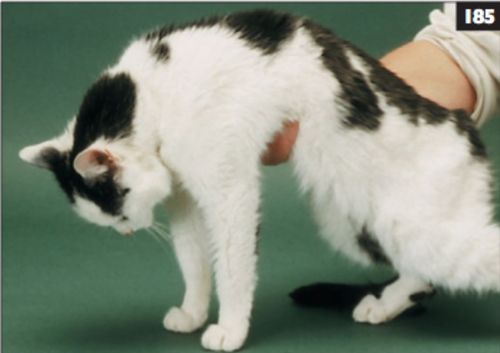Difference between revisions of "Feline Medicine Q&A 14"
(Created page with "{{Template:Manson Sparkes}} [[Image:|centre|500px]] <br /> '''This 10-year-old neutered female DSH cat has a history of polydipsia/polyuria, weight loss, and intermittent vomi...") |
Ggaitskell (talk | contribs) |
||
| (2 intermediate revisions by one other user not shown) | |||
| Line 1: | Line 1: | ||
{{Template:Manson Sparkes}} | {{Template:Manson Sparkes}} | ||
| − | [[Image:|centre|500px]] | + | [[Image:Feline Medicine 14.jpg|centre|500px]] |
<br /> | <br /> | ||
| Line 13: | Line 13: | ||
|a1= | |a1= | ||
This cat is showing ventroflexion of the neck, a classic sign of neuromuscular weakness. | This cat is showing ventroflexion of the neck, a classic sign of neuromuscular weakness. | ||
| − | |l1= | + | |l1=Neurological Examination - Dog & Cat#Posture |
|q2=What differential diagnoses should be considered? | |q2=What differential diagnoses should be considered? | ||
|a2= | |a2= | ||
| Line 21: | Line 21: | ||
*Junctionopathies: myasthenia gravis (congenital, acquired, paraneoplastic), organophosphate intoxication. | *Junctionopathies: myasthenia gravis (congenital, acquired, paraneoplastic), organophosphate intoxication. | ||
Hypokalaemia is probably the single most common cause of this type of presentation. | Hypokalaemia is probably the single most common cause of this type of presentation. | ||
| − | In this cat, the accompanying clinical signs (polydipsia, polyuria, weight loss, and intermittent vomiting) would be strongly suggestive of hypokalaemia secondary to CRF. However, hyperthyroidism would also be an important differential, as would | + | In this cat, the accompanying clinical signs (polydipsia, polyuria, weight loss, and intermittent vomiting) would be strongly suggestive of hypokalaemia secondary to CRF. |
| + | |||
| + | However, hyperthyroidism would also be an important differential, as would | ||
paraneoplastic disease (e.g. with hypercalcaemia causing polyuria and polydipsia). | paraneoplastic disease (e.g. with hypercalcaemia causing polyuria and polydipsia). | ||
| − | |l2= | + | |l2=Hypokalaemia |
|q3=What are the priorities for further investigation? | |q3=What are the priorities for further investigation? | ||
|a3= | |a3= | ||
| − | Priorities for further investigation would be a thorough history, physical and neurological examination. A neurological examination should aim to detect any specific deficits, and distinguish muscle weakness from neurological disease (e.g. by careful assessment of proprioceptive responses). Initial screening blood tests should include serum biochemistry (including CK, urea, creatinine, calcium, phosphate, sodium, potassium, thyroxine) and urinalysis. | + | Priorities for further investigation would be a thorough history, physical and neurological examination. |
| − | |l3= | + | |
| + | A neurological examination should aim to detect any specific deficits, and distinguish muscle weakness from neurological disease (e.g. by careful assessment of proprioceptive responses). | ||
| + | |||
| + | Initial screening blood tests should include serum biochemistry (including CK, urea, creatinine, calcium, phosphate, sodium, potassium, thyroxine) and urinalysis. | ||
| + | |l3=Neurological Examination - Dog & Cat#Further Investigation | ||
</FlashCard> | </FlashCard> | ||
Latest revision as of 11:34, 25 August 2011
| This question was provided by Manson Publishing as part of the OVAL Project. See more Feline Medicine questions |
This 10-year-old neutered female DSH cat has a history of polydipsia/polyuria, weight loss, and intermittent vomiting.
| Question | Answer | Article | |
| What is the most obvious feature this cat is displaying? | This cat is showing ventroflexion of the neck, a classic sign of neuromuscular weakness. |
Link to Article | |
| What differential diagnoses should be considered? | This is not a specific clinical sign and can be caused by numerous myopathies, neuropathies, or ‘junctionopathies’.
Hypokalaemia is probably the single most common cause of this type of presentation. In this cat, the accompanying clinical signs (polydipsia, polyuria, weight loss, and intermittent vomiting) would be strongly suggestive of hypokalaemia secondary to CRF. However, hyperthyroidism would also be an important differential, as would paraneoplastic disease (e.g. with hypercalcaemia causing polyuria and polydipsia). |
Link to Article | |
| What are the priorities for further investigation? | Priorities for further investigation would be a thorough history, physical and neurological examination. A neurological examination should aim to detect any specific deficits, and distinguish muscle weakness from neurological disease (e.g. by careful assessment of proprioceptive responses). Initial screening blood tests should include serum biochemistry (including CK, urea, creatinine, calcium, phosphate, sodium, potassium, thyroxine) and urinalysis. |
Link to Article | |
